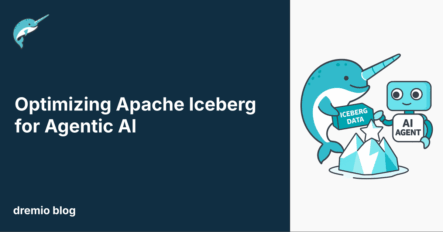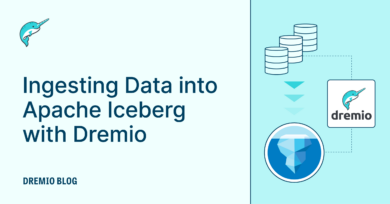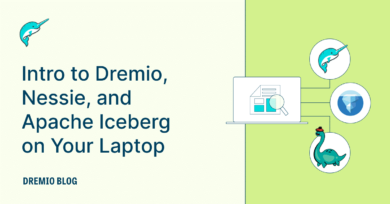
Building intelligent systems that can autonomously reason, learn, and act—what we call Agentic AI—requires more than just clever algorithms. These agents need fast, reliable access to a wide array of data across an organization to contextualize decisions, respond to real-time inputs, and maintain relevance as conditions change. But in many enterprises, data is scattered across silos, trapped in legacy formats, or locked behind brittle pipelines.
Apache Iceberg offers a powerful path forward. As an open table format designed for analytical data lakes, it helps standardize how large-scale data is stored, queried, and managed. By adopting Iceberg, teams gain the flexibility to build shared, high-quality data assets that can fuel AI-driven automation across departments.
Yet, this flexibility comes with trade-offs. Running a lakehouse on Apache Iceberg isn't as simple as flipping a switch, it demands careful attention to cataloging, metadata cleanup, and performance tuning. Without the right tools, those responsibilities can slow progress or introduce costly complexity.
That’s where Dremio enters the picture. By bridging the operational gaps and providing seamless query acceleration, governance, and federation, Dremio enables organizations to operationalize Apache Iceberg at scale confidently. The result? A streamlined path to building Agentic AI applications that can tap into enterprise data—wherever it lives—with speed and clarity.
What Is Agentic AI and Why It Matters
Agentic AI refers to systems that operate with a degree of autonomy—taking in data, making decisions, and executing tasks without constant human input. These systems aren’t just answering questions; they’re navigating workflows, chaining actions together, and adapting to new information as it becomes available.
Think of a personal research assistant that not only searches documents for answers but cross-references sources, summarizes insights, and drafts a report—all while learning your preferences over time. That’s the promise of Agentic AI: intelligent agents that don’t just respond but act.
But realizing this vision requires more than advanced models. These agents need broad, consistent access to data across domains—marketing data, finance metrics, product telemetry, external APIs, and more. The more siloed or inconsistent that data is, the more fragile the agent becomes. Without unified access, agents risk operating in the dark, basing decisions on partial or outdated information.
To make Agentic AI a reality, organizations need a modern data foundation—one that ensures data is not just stored, but also discoverable, shareable, and queryable in real time. That foundation must span multiple teams, tools, and storage systems without introducing excessive complexity. This is where Apache Iceberg starts to play a central role.
Why Wrangling Enterprise and External Data Is Critical for Agentic AI
Agentic AI thrives on context. To act intelligently, agents must pull together a complete picture—piecing together internal datasets like CRM records or system logs with external sources like market feeds, third-party APIs, or geospatial data. The broader the data landscape, the smarter and more capable the agent.
But that landscape is rarely unified.
Most organizations operate with fragmented data ecosystems. Teams often rely on different storage layers, query engines, and governance policies. Some data lives in data lakes as Parquet or JSON files, others in operational databases or SaaS platforms. The end result is a patchwork of pipelines, duplicate datasets, and fragile connections—hardly the environment you want powering autonomous agents.
Even worse, this fragmentation slows iteration. Developers must juggle credentials, parse mismatched schemas, and debug inconsistent behavior across environments. This overhead makes it harder to prototype, test, and deploy agentic workflows.
To address this, organizations must invest in a data architecture that supports enterprise-wide interoperability. That means:
- Standardizing how data is stored and accessed across departments and tools
- Enabling consistent semantics and governance without duplicating effort
- Allowing real-time and batch access to both raw and refined datasets
Apache Iceberg is uniquely positioned to help here, providing a standardized format for managing tabular data across diverse compute engines. But to make that vision usable in practice, teams need the right tooling to simplify its management and extend its reach across all their data—structured or not.
Try Dremio’s Interactive Demo
Explore this interactive demo and see how Dremio's Intelligent Lakehouse enables Agentic AI
Why Standardizing on Apache Iceberg Unlocks Data for AI
When each team in an organization works with data in its own format, stored in its own system, collaboration becomes complicated. Analytics teams might rely on Parquet files in S3, while product engineers query a Postgres database, and finance pulls CSVs into spreadsheets. Getting a unified view requires copying data, translating formats, and constantly troubleshooting sync issues.
Apache Iceberg helps change that dynamic.
As an open table format, Iceberg adds structure, consistency, and versioning to data stored in the data lake. Instead of working with raw files, teams can treat their data more like a database—with support for ACID transactions, schema evolution, and time travel. Whether you’re using Spark, Flink, Dremio, or another engine, Iceberg provides a common interface for querying and managing tabular data.
By standardizing on Iceberg, organizations can:
- Create a shared data layer accessible to different teams and tools without format conversions
- Apply governance policies centrally while enabling decentralized data ownership
- Support scalable, performant access for AI applications that need to scan and process large datasets efficiently
This common foundation not only simplifies data engineering but also accelerates experimentation. Agents can discover and query the same datasets regardless of which system or language they operate in. Analysts, developers, and ML engineers can all work from a single, coherent source of truth.
Of course, getting to this state isn’t automatic. Deploying and managing an Iceberg lakehouse introduces its own set of challenges—ones that need to be addressed to truly enable Agentic AI at scale.
The Challenges of Managing an Iceberg Lakehouse
While Apache Iceberg brings powerful capabilities to the modern data stack, adopting it at scale comes with operational trade-offs. Iceberg is a specification—not a plug-and-play platform—so teams must take responsibility for assembling the components needed to run and maintain a reliable lakehouse.
One of the first hurdles is provisioning and managing a catalog. Iceberg tables require a catalog to track metadata and enable transactional operations. Organizations must choose between options like Hive Metastore, AWS Glue, or REST-based catalogs, each with its own setup, scaling, and security considerations. Inconsistencies here can lead to compatibility issues across engines or difficulties in governing access.
Beyond the catalog, there’s the task of table governance. As datasets grow and evolve, tracking lineage, enforcing schema controls, and managing access policies becomes increasingly important. Without clear governance, it’s easy to end up with version drift or data that’s technically “there” but unusable in practice.
Performance is another major concern. Iceberg’s design favors large-scale, append-only workloads, but keeping query times fast requires ongoing table maintenance. That includes:
- Compacting metadata and data files to reduce fragmentation
- Expiring old snapshots to control storage costs
- Partitioning tables effectively for query pushdown
Left unchecked, these small tasks add up—slowing queries, bloating storage, and frustrating developers trying to build responsive Agentic AI systems.
Finally, not all enterprise data will be in Iceberg right away. There’s always a long tail of legacy systems, relational databases, and external APIs that agents need access to. Any viable Iceberg deployment must coexist with these sources, not replace them entirely.
In short, while Iceberg sets the stage for a standardized, AI-ready data lakehouse, realizing that potential requires orchestration, tooling, and automation that many teams struggle to implement alone.
How Dremio Solves the Iceberg and Agentic AI Challenges
Dremio isn’t just another query engine—it’s a full platform designed to make enterprise data more usable, governable, and performant, especially when paired with Apache Iceberg. For teams building Agentic AI applications, Dremio removes many of the complexities that would otherwise slow progress.
At the heart of Dremio’s value is query federation. Agentic systems often need to pull from a mix of Iceberg tables, relational databases, and external cloud sources. Rather than juggling credentials and connection logic in your code, Dremio allows agents to access all these sources through a single, unified interface. This streamlines development and improves scalability without compromising on data security or governance.
When it comes to managing Apache Iceberg directly, Dremio provides a turnkey lakehouse experience. It includes:
- An integrated Iceberg catalog powered by Apache Polaris, which tracks and governs table metadata without requiring separate infrastructure
- Native optimizations for Iceberg queries, ensuring fast performance even as tables grow
- Automated table maintenance—such as file compaction and snapshot expiration—so engineers don’t have to script cleanup jobs
Dremio also rethinks query acceleration through its Reflections engine. Instead of replicating your data into a separate proprietary system system like many platforms do with materialized views on Iceberg tables, Reflections work within your Iceberg lake. They leverage your existing data layout, track relationships across datasets, and accelerate queries by intelligently using precomputed data structures that stay in sync with the source.
Reflections can be:
- Autonomous, created and refreshed automatically based on query patterns
- Incremental, minimizing compute and storage overhead by updating only what’s changed
- Reusable, thanks to Dremio’s semantic layer that understands how datasets relate across your organization
This approach ensures that Agentic AI systems can access fresh, fast data without relying on manual tuning or redundant storage layers. It also reduces latency, which is critical for real-time or near-real-time decision-making.
By combining query federation, Iceberg-native optimization, and autonomous performance tuning, Dremio becomes more than a backend. It becomes the intelligent access layer that enables Agentic AI to thrive across the enterprise.
Conclusion
Agentic AI holds enormous potential—but only if it’s backed by a data architecture that can keep up. These intelligent agents depend on consistent, low-latency access to a wide range of data, both internal and external. That kind of access isn’t possible when data lives in silos or is tied up in legacy formats.
Apache Iceberg provides a path to standardize data across the enterprise, bringing structure, scalability, and openness to data lakes. But standing up an Iceberg lakehouse on your own comes with a learning curve: managing catalogs, optimizing queries, maintaining metadata, and integrating with other systems.
With Dremio, teams gain two key advantages for enabling Agentic AI:
- The ability to standardize data with Iceberg while simplifying its management through integrated cataloging, automated maintenance, and intelligent performance acceleration
- The ability to break silos through query federation, giving AI systems seamless access to relational databases, cloud storage, and external data without needing to replicate or reformat it
By using Dremio as the data gateway, organizations improve security, reduce complexity, and give their agents the reliable, performant access they need—without reinventing the data stack. This frees developers to focus less on credentials, connectors, and workarounds, and more on building the intelligent workflows that drive business impact.
Get Hands-On with Dremio
If you're exploring how to scale Agentic AI or modernize your data architecture with Apache Iceberg, the best way to understand Dremio’s impact is to try it yourself.
You can get started in minutes at dremio.com/get-started, where you’ll find everything you need to spin up a project, connect data sources, and explore your lakehouse with real workloads.
Prefer a guided tour? Join one of our upcoming workshops at dremio.com/events to see how Dremio helps organizations simplify Iceberg adoption, optimize performance, and enable next-generation data applications—including Agentic AI.


